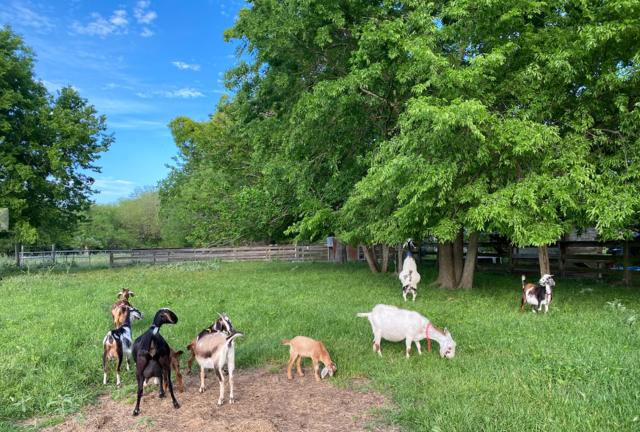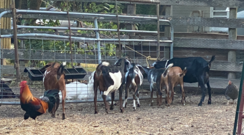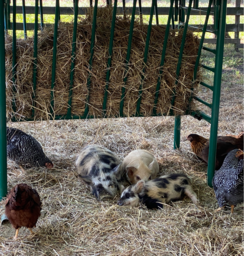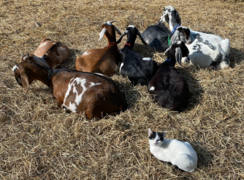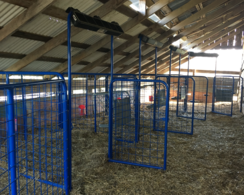Herd Management
Goats and Kunekune
Pasture
Pasture is prioritized here at Babka Farms. The following schedule allows for at least some rest period from each species for the pastures. The Kunekune are put into a pasture either at the same time or after the goats are moved out (depending on kidding/farrowing schedules). Their love of "goat berries" and consumption of parasite infested grass does a great job at reducing any parasites in the pasture.
Babka Farms Youtube Channel: Pasture Raised
Article from The Fence Post on multi-species grazing
Article from Earth Eats
A regenerative farmer enlisted livestock "teammates"
Feeding
Hay: My goats love and thrive on the hay from our own hay field. I feed this free choice 24/7. I try to only feed organically raised or organic hay. This adds to the expense, but also adds to their health/vitality and thus the quality of the milk.
Alfalfa - Occasionally during the year and regularly beginning with the month prior to kidding my does (and then kids) get alfalfa. I use both alfalfa hay and a product like Alfahay or Chaffhaye.
Bucks - hay and some supplemental feed/grain just before/during/after breeding season.
Milking Does - They get grain on the milk stand. I adjust the amount based on body condition and time to milk. I try and feed minimum grain, preferring to have nutrient dense pasture and hay available for them. However, I keep a close eye on milk production, growth of kids, and dam's condition. I'm still perfecting the nutrient quality of the pastures I have available for them and get a quality organic dairy goat feed from Kalmbach.
Kids - The kids are raised on their dams. I do train to the bottle, seperate kids at night and sometimes switch to bucket feeding as they get older. The bucklings can be rough on the dam's udder so they end up getting weaned off mom sooner than the doelings. I've found my kids do grow very nicely on goats milk and so I do not rush weaning. I will sell kids at 8-12 weeks but I do recommend supplementing with bottles until around 16 weeks. Kids also get hay as soon as they are interested and are out on pasture with their dams.
Extras! Treats added to feed or fed on special occasions include Black Oil Sunflower Seeds, Pumpkin Seeds, Oak tree trimmings, and alfalfa/timothy pellets.
Podcast: For the Love of Goats: Natural Parasite Control with Lespedeza
Lespedeza Pellets at New Country Organics
Housing
I have three sided structures for the bucks and kunekune. The does and kids have access to a leanto on the side of the barn. These structures have worked very nicely for the adult animals even in the coldest weather (20ish degrees) as long as there is a nice pile of hay and friends to cuddle with. I have a set of 5 kidding pens that I set up in the leanto (see picture). If I have any does due in January or February I will set up kidding stalls in the barn for extra protection from the cold. Thankfully in February 2021 during the winter storm I had the kidding stalls in the barn. My stalls are an awesome complement to my infrastructure, and that is what you want to look for when creating your housing for your animals. I can move them from the leanto (where they spend most of the year). I use them to make the kidding stalls in the barn and to make the breeding pens in the Center pasture. I can also open them up to make more space in the leanto after kidding season is complete.
Parasites
Pasture Rotation - I'm not set up for frequent pasture rotation, such as every few days. I have 4 pastures. I rotate the kunekune and goats into a new pasture about every 3-4 months.
Hay and Adequate Protien - Thriving goats are much less susceptible to parasites. Ensure a strong nutritional base for your goats health.
Water - I occasionally put soap in the water after finding this was a practice from years ago for deworming. Ask me for more info. I also linked a video below for more information.
BioWorma - This product is a little expensive, but has been working great for the pastures. It is a supplement I feed to the goats, but it just passes through their system. The fungus is expelled in their droppings where it attacks and kills any parasite larva. I add it to the feed for the does from March - May and to the bucks feed in July and August. This covers all the pastures during times of high stress (lactation for the does and rut for the bucks).
Lespedeza - I give this as often as I can find it in stock. High in tannins which have been shown to create an environment that the internal parasites find inhospitable, it can be fed in pellets or hay. I feed the pellets from kidding to the start of going out on pasture for the whole herd. I continue feeding to kids during their first year as it also deters coccidia. Although, I may feed year round as soon as it is more available.
Herbal Wormers - I use the liquid Worm Away from Higher Ground Herbs and Homestead for animals showing acute signs of parasite overload. I have some other herbal worming formulas in powdered form that I occasionally give free choice. I am not convinced these powdered herb formulas work on parasites as they did not seem to help my herd. However, I believe there are a lot of good nutrients in the variety of herbs offered. By occasionally providing the herbals free choice mixed with kelp (so they don't blow away) it gives the goats opportunity to supplement their diet.
Copper Oxide - It is important to know what level of copper supplementation your goats need to avoid copper toxicity which can be deadly. I am in a copper deficient area and had been giving my goats a copper bolus twice a year for a total of 8 grams per year. Now with the individual minerals available to htem I no longer have a regular copper bolus schedule. I linked a podcast and an article below to help you determine how to apply the use of copper oxide for barberpole. I use the FAMACHA scoring and Fecal Egg Counts (FEC) to determine the need for deworming. If needed I give 1 gram to adults and 1/2 a gram for kids under a year of the Copper Oxide - usually in a fig newton but some prefer it mixed with molasses and a small amount of feed.
Babka Farms YouTube Channel: Natural Dewormer Routine and Free Choice Minerals
Copper Oxide on For the Love of Goats Podcast
Garlic Juice Study on Deworming
ACSRPC Copper Oxide Fact Sheet
Video on using soap in water for worming from Brett's Barnyard
Monday, March 25, 2024
